Growing Rice At Home: Learn How To Grow Rice
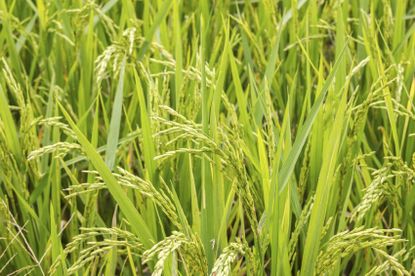
Rice is one of the oldest and most revered foods on the planet. In Japan and Indonesia, for instance, rice has its own God. Rice requires tons of water plus hot, sunny conditions to grow to fruition. This makes planting rice impossible in some areas, but you can grow your own rice at home, sort of.
Can You Grow Your Own Rice?
While I say “sort of,” growing rice at home is definitely possible, but unless you have a large rice paddy outside your back door, it is unlikely you will be harvesting much. It is still a fun project. Growing rice at home takes place in a container, so only a small space is needed, unless you decide to flood the backyard. Read on to find out how to grow rice at home.
How to Grow Rice
Planting rice is easy; getting it to grow through harvest is challenging. Ideally, you need at least 40 continuous days of warm temps over 70 F. (21 C.). Those of you who live in the South or in California will have the best luck, but the rest of us can also try our hand at growing rice indoors, under lights if necessary. First, you need to find one or several plastic containers without holes. One or several depends upon how many miniature pseudo rice paddies you want to create. Next, either purchase rice seed from a gardening supplier or buy long grain brown rice from a bulk foods store or in a bag. Organically grown rice is best and it can’t be white rice, which has been processed. Fill the bucket or plastic container with 6 inches (15 cm.) of dirt or potting soil. Add water up to 2 inches (5 cm.) over the soil level. Add a handful of the long grain rice to the bucket. The rice will sink to the dirt. Keep the bucket in a warm, sunny area and move it to a warm place at night.
Care of Rice Plants
Rice plants don’t need too much care from here on out. Keep the water level at 2 inches (5 cm.) or so above the dirt. When the rice plants are 5-6 inches (12.5-15 cm.) tall, increase the water depth to 4 inches (10 cm.). Then, allow the water level to lower on its own over a period of time. Ideally, by the time you harvest them, the plants should no longer be in standing water. If all goes well, rice is ready to harvest in its fourth month. The stalks will go from green to gold to indicate it is time to harvest. Harvesting rice means cutting and gathering the panicles attached to the stalks. To harvest the rice, cut the stalks and allow them to dry, wrapped in a newspaper, for two to three weeks in a warm, dry place. Once the rice stalks have dried, roast in a very low heat oven (under 200 F./93 C.) for around an hour, then remove the hulls by hand. That’s it; you can now cook with your very own home grown, long grain brown rice.
Gardening tips, videos, info and more delivered right to your inbox!
Sign up for the Gardening Know How newsletter today and receive a free download of our DIY eBook "Bring Your Garden Indoors: 13 DIY Projects For Fall And Winter".

Amy Grant has been gardening for 30 years and writing for 15. A professional chef and caterer, Amy's area of expertise is culinary gardening.
-
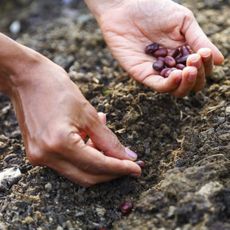 Best Seeds For Survival – Grow A Garden That Can Outlast Almost Anything
Best Seeds For Survival – Grow A Garden That Can Outlast Almost AnythingUncertain about the future? Why not try seeds? They’re easy to save and provide a safety net for good times and bad.
By Bonnie L. Grant
-
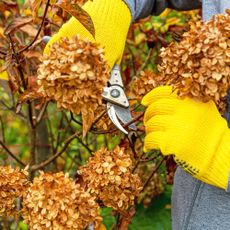 Should You Cut Back Perennials In The Fall? – When To Tidy Up And When To Leave Plants Alone
Should You Cut Back Perennials In The Fall? – When To Tidy Up And When To Leave Plants AloneIt's tempting to prune plants during the fall garden cleanup, but is it the right thing to do? Discover whether to make the cut – or embrace the mess.
By Amy Grant
-
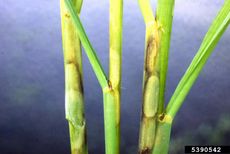 What Is Rice Sheath Blight: Treating Sheath Blight Of Rice
What Is Rice Sheath Blight: Treating Sheath Blight Of RiceAnyone who is growing rice needs to learn the basics about diseases that affect this grain. One particularly destructive disease is called rice sheath blight. What is rice sheath blight? What causes rice sheath blight? Click here to get answers to your questions.
By Teo Spengler
-
What Is Rice Straighthead: Treating Rice With Straighthead Disease
In the United States, straighthead disease of rice has been a significant problem since rice crops were first grown in the early 1900s. It appears that although arsenic is partly to blame, there are other factors as well. Click here for more information.
By Mary H. Dyer
-
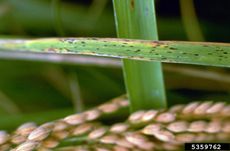 Rice Leaf Smut Info – How To Treat Leaf Smut Of Rice Crops
Rice Leaf Smut Info – How To Treat Leaf Smut Of Rice CropsRice may not be a typical backyard garden plant, but if you live somewhere soggy, it can be a great addition. Diseases can ransack your rice paddy, though, so be aware of signs of infections like leaf smut of rice and what to do to manage or treat it. Learn more here.
By Mary Ellen Ellis
-
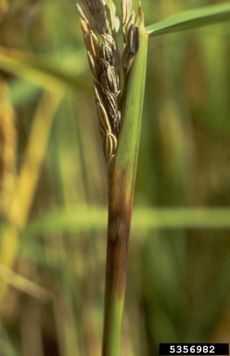 What Is Rice Sheath Rot: How To Recognize Rice Black Sheath Rot Symptoms
What Is Rice Sheath Rot: How To Recognize Rice Black Sheath Rot SymptomsRice is one of the most important crops in the world. So when rice has a disease, it is serious business. Such is the problem with sheath rot of rice. What is rice sheath rot? Click here for diagnostic information and advice on treating rice sheath rot in the garden.
By Bonnie L. Grant
-
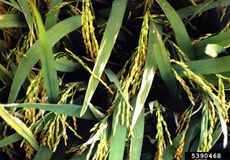 Rice Bacterial Leaf Blight Control: Treating Rice With Bacterial Leaf Blight Disease
Rice Bacterial Leaf Blight Control: Treating Rice With Bacterial Leaf Blight DiseaseBacterial leaf blight in rice is a serious disease that, at its peak, can cause losses of up to 75%. In order to effectively control rice with bacterial leaf blight, it is important to understand what it is, its symptoms, and the conditions that foster the disease. This article will help.
By Amy Grant
-
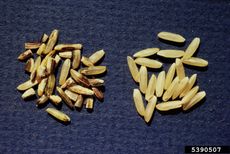 Kernel Smut Of Rice Crops: How To Treat Rice Kernel Smut
Kernel Smut Of Rice Crops: How To Treat Rice Kernel SmutWhether growing a field of rice crops or just a few rice plants in the garden, you may at some point come across some kernel smut of rice. What is this and how can you alleviate the problem? Click the following article to learn more.
By Becca Badgett
-
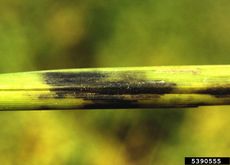 Rice Stem Rot Control – A Guide To Treating Rice Stem Rot Disease
Rice Stem Rot Control – A Guide To Treating Rice Stem Rot DiseaseAs yield losses continue to rise from stem rot in rice, new studies are being conducted to find effective methods of rice stem rot control and treatment. Click this article to learn what causes rice stem rot, as well as suggestions for treating rice stem rot in the garden.
By Darcy Larum
-
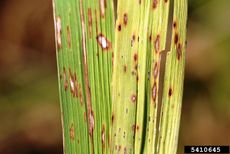 Rice Cercospora Disease – Treating Narrow Brown Leaf Spot Of Rice
Rice Cercospora Disease – Treating Narrow Brown Leaf Spot Of RiceRice can be grown successfully with careful planning and knowledge. However, many issues plague rice plants, leading to reduced yields, and even crop loss. One such disease, narrow brown leaf spot, remains troublesome for many growers. Click here to learn more.
By Tonya Barnett